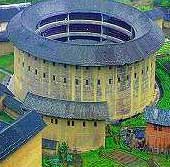
Regarded by architects as the cream of Chinese traditional residential architecture, tulou, or earth buildings, first appeared about 1,200 years ago, and were mostly completed in the Ming (1368-1644) and Qing (1644-1911) dynasties. They were built and inhabited by the Hakka people – a group belonging to the Han family who can trace their ancestors back more than 1,500 years to central and north China. During the hundreds of years of migration, the Hakka people tried to maintain their own culture and way of life, keeping their own unique dialect, custom and cuisine. They built the earth complexes to guard against invasion from local bandits and to protect their children from the influence of local communities. All the families of a Hakka clan lived together in an enclosed rammed earth building.

good